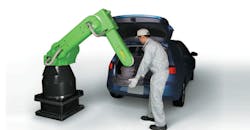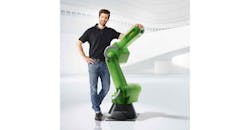How to (Safely) Harness the Power of Collaborative Robotics
Over the last few years, a new concept of robotics has quietly crept into the industry. Today, suddenly, they seem to be ready for a manufacturing takeover.
This new concept—dubbed "collaborative robotics"—allows humans and robots to work together without safety fences, guards, or complicated programming standing in the way.
In the right environment—and performing the right tasks—this new generation of robots can become a coworker on the line, performing often mindless, repetitive tasks with the same speed and dexterity as a human, and requiring about as much training and floor space as them, too.
With those benefits, and a price point far below that of traditional industrial robots, these machines are bringing automation to factories and settings that could never fit (or afford) them before.
So, from the manufacturing side, these things offer some very clear and very potent advantages.
But from the EHS perspective, they offer a complicated new safety puzzle to work out before they can get to work.
Luckily Paul Santi—General Manager of FANUC America's Powertrain Systems Group—was on-hand at the 2016 Safety Leadership Conference to get us started.
"The technology has been rewritten," Santi told the EHS Today crowd during his presentation. "We're driving robots and people to work together."
And he is doing it in a big way. After years of development—both on the mechanical and regulations side of the puzzle—FANUC entered the collaborative arena last year with an entire fleet of smart, padded, intrinsically safe machines that are ready to be put to work just about anywhere on the factory floor.
This same move is being repeated across the industry with every major robot manufacturer. Collaborative technologies, Santi said, is already taking the industry by storm. IFR's World Robotics Report 2016, for example, predicts global annual sales of industrial robots to grow over 13% over the next three years, driven largely by the proliferation of these new collaborative models.
The reason for this surge, Santi said, is clear: these machines, such as the CR-35iA, can offer manufacturers a simple (and much needed) productivity boost.
The six-axis CR-35iA's soft foam green cover protects workers who are in direct contact with the robot.
Learn more on the NED directory!
But, he cautioned, these amazing new robots are still machines. And like any machine, they must be setup thoughtfully, carefully, and by the book to guarantee safe applications—even if they are "inherently safe."
To help with that part, Santi offered three steps to help manufacturers join the revolution.
Joining the Collaborative Revolution
1. Do Your Homework
Before you buy a collaborative robot, "you have to ask why your company is going collaborative," Santi said. "Is it for the right reasons?"
To many early adopters are jumping in because, Santi noted, "everyone else is doing it," or because they are so cheap and small they figure they can pick one up and find a place to use them later.
But that is preposterous. The only valid reason to purchase one of these—or any piece of industrial equipment—is if it actually adds something essential to the process.
To determine that, Santi said, there are a couple of manufacturing issues to consider.
"These robots still need to achieve production and quality levels and you still need to control the process," he said. "Will the robot communicate with external equipment? Does it have to integrate with other operations?"
If all of that works out, then you have to figure out exactly what type of collaborative you need.
When most people hear "collaborative," they generally think of slow-moving, force limiting robots. But, according to the latest ISO Robot standards, there are actually five distinct collaborative categories, each offering unique capabilities and safety features.
- Hand Guiding
- Uses standard industrial robots
- Requires sensor to detect applied forces
- Used for hand guiding and path teaching
- Does not make robot collaborative in other functions/modes
- Power and Force Limiting
- Not standard industrial robot
- Has force-limited features
- Does not require additional safety devices
- Used for direct collaboration with the workers
- Safety Monitored Stop
- Uses standard industrial robots
- Equipped with safety devices that detect workers
- Used for sparse cooperative operations
- Speed and Separation Monitoring
- Uses standard industrial robots
- Requires vision system to detect workers
- Used for operations requiring frequent worker presence
2. Risk Assessments
"The first question to ask [when setting up a collaborative robot] is what are the robots really doing?" Santi explained. "What is the robot doing and are there hazards you need to protect people from?"
Basically, this means that collaborative applications—just like anything else—still require safety assessments.
There are a number of factors to consider in these assessments.
Force limiting robots, for example, automatically stop when they come in unexpected contact with a coworker (or anything else). And that's fine if the worker is standing in free space and the robot is moving something small.
But if the robot is moving something heavy or sharp, even a minor contact can be dangerous. Or, if the worker is in a confined space, such contact can pinch or pin him/her, potentially causing significant injury.
The EHS team has to look carefully at every application to determine what protections collaborative robots require or if they are even appropriate.
3. Training
For a generation of manufacturers accustomed to working with robots safely tucked away into their safe spaces, collaboratives can be quite a shock.
"For the past 30 years, you only went in [robotic cells] when there was a problem," Santi explains. "That philosophy is changing."
These new robots are meant to be touched and manipulated while in process—even as a part of the process. Convincing workers to do that (after decades of contrary training) will take some time.
Santi expects newest generation of workers to take to this technology without much issue at all, though.
"The younger generation accepts technology and trusts software much more than previous generations," Santi said. "They will probably trust this technology in the workplace much easier."
However, there is a downside to that.
"They have to learn to differentiate between the old robots and these new ones that they can go and touch," he explained.
The solution to that, of course, is training. Continuous training to keep workers young and old working safe and efficiently with the latest tools.
Collaboratives Are Here to Stay
There is a great deal of hype surrounding these new robots, but Santi sees them as much more than a passing trend.
"Collaborative robot applications are not diminishing," he told the crowd. "They are increasing."
In that case, EHS professionals and manufacturers need to get in now and understand the benefits and challenges this technology presents.
And, even though the development has the potential to fundamentally change the robotics industry, there are a few common parts that have persisted to help us deal with the changes.
"What mattered yesterday still matters today and will still matter tomorrow" Santi said. "We still need productivity, interoperability, capability, durability, flexibility, and reliability."
These new tools, he said, still live up to that standard.
About the Author
Travis Hessman
VP of Content, Endeavor Business Media
Travis Hessman is the VP of Content for Endeavor Business Media. Previously, Travis was the Editor-in-Chief for Industry Week and New Equipment Digest as well as the Group Editorial Director for Endeavor's Manufacturing Group.
He began his career as an intern at IndustryWeek in 2001 and later served as IW's technology and innovation editor. Today, he combines his experience as an educator, a writer, and a journalist to help address some of the most significant challenges in the manufacturing industry, with a particular focus on leadership, training, and the technologies of smart manufacturing.


